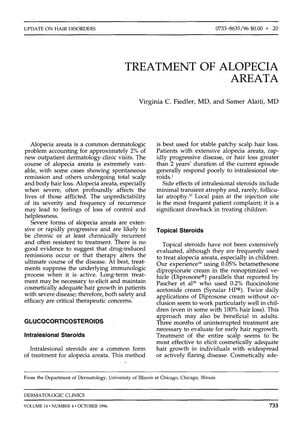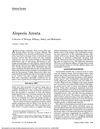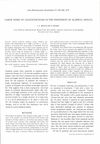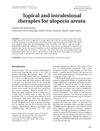TREATMENT OF ALOPECIA AREATA
October 1996
in “Dermatologic clinics”

TLDR Some treatments can help with hair regrowth in alopecia areata, but results vary and long-term use is often needed without changing the disease's outcome.
In 1996, various treatments for alopecia areata were discussed, including intralesional steroids for patchy hair loss, topical steroids like 0.05% betamethasone dipropionate cream, systemic steroids for extensive hair loss, anthralin for patients with less than 75% scalp hair loss, and topical and oral minoxidil. While some treatments showed efficacy, such as a cosmetic response in a subset of patients using 5% minoxidil, the effectiveness varied, and long-term use was often necessary without altering the disease's course. Side effects were a concern, with one patient discontinuing treatment due to dermatitis, but no systemic effects from minoxidil were noted. The document recommended practical management strategies, including treating the entire scalp, waiting at least 3 months before changing treatments, and considering maintenance therapy. It also suggested that atopic patients with seasonal hair loss might benefit from antihistamines or mast cell stabilizers. Despite the variability in treatment response, the importance of seeking safe and effective long-term treatments was emphasized.
View this study on sciencedirect.com →
Cited in this study

research Alopecia Areata
Different treatments for alopecia areata have varying success rates and side effects; intralesional steroids are most effective.

research Topical Minoxidil in Alopecia Areata: No Effect on the Perifollicular Lymphoid Infiltration
Minoxidil doesn't affect perifollicular lymphoid infiltration in alopecia areata patients.
research Treatment-Resistant Alopecia Areata
research (5) Topical cyclosporin A in alopecia totalis: failure of therapeutic effect due to lack of penetration

research Evaluation of Oral Minoxidil in the Treatment of Alopecia Areata
Oral minoxidil helps hair regrowth in 80% of alopecia patients, but only 18% see cosmetic improvement.

research Topical minoxidil solution (1% and 5%) in the treatment of alopecia areata
Minoxidil solution helps hair regrowth in alopecia areata, with 5% being more effective.

research Topical Minoxidil in Extensive Alopecia areata, Including 3-Year Follow-Up
Topical minoxidil effectively and safely treats extensive alopecia areata but doesn't change its course.

research Alopecia Areata Treated With Topical Minoxidil
Minoxidil can help regrow hair in alopecia areata patients.

research Large doses of glucocorticoid in the treatment of alopecia areata
Large doses of glucocorticoids are not suitable for general use in treating severe alopecia areata due to inconsistent results and risks.
Related
research Treating of resistant cases of alopecia universalis
Combining platelet-rich plasma therapy with prostaglandin-F eye drops can significantly regrow hair in alopecia universalis.

research Topical and intralesional therapies for alopecia areata
No treatments fully cure or prevent alopecia areata; some help but have side effects or need more research.